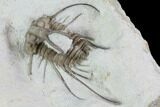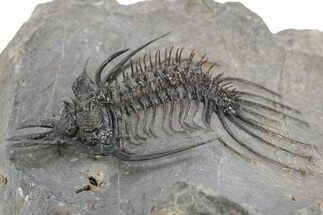This Specimen has been sold.
2.15" Dicranurus Trilobite - Black Cat Mountain, Oklahoma
This is a 2.15" long specimen of the spiny Dicranurus elegans, one of the rarer trilobites from the Haragan Formation. Typically only a few of them are found each digging season at the Black Cat Mountain Quarry. It's long, flowing spines and distinctive "rams horns" make it a much sought after trilobite.
The Black Cat Mountain Quarry produces a limited number of arguably the most beautiful trilobites in the United States each year. Each specimen is meticulously prepared by quarry owner Bob Carroll under microscope to expose the smallest details. This is a very time consuming process, taking many hours, but yields spectacular results.
About Trilobites
Trilobites are an extinct class of marine arthropods that thrived for nearly 270 million years, from the early Cambrian to the end of the Permian period (around 521 to 252 million years ago). They are one of the most successful and diverse groups in the history of life, with over 25,000 described species spanning a wide range of sizes, shapes, and ecological niches. Known for their distinctive, segmented exoskeletons, trilobites provide invaluable insights into the evolutionary history of arthropods and the dynamics of ancient marine ecosystems.
Trilobites are an extinct class of marine arthropods that thrived for nearly 270 million years, from the early Cambrian to the end of the Permian period (around 521 to 252 million years ago). They are one of the most successful and diverse groups in the history of life, with over 25,000 described species spanning a wide range of sizes, shapes, and ecological niches. Known for their distinctive, segmented exoskeletons, trilobites provide invaluable insights into the evolutionary history of arthropods and the dynamics of ancient marine ecosystems.
SPECIES
Dicranurus elegans
AGE
LOCATION
Black Cat Mountain, Clarita, Oklahoma
FORMATION
Haragan Formation
SIZE
2.15" long (including spines)
CATEGORY
SUB CATEGORY
ITEM
#94646
We guarantee the authenticity of all of our specimens.
 Reviews
Reviews














